Information System and Analysis of Big Data
VerifiedAdded on 2023/06/10
|10
|2986
|440
AI Summary
This report evaluates the theories, methods and techniques related to the design and development of information systems. It also discusses the impact of IT on globalization, digital infrastructure, and risks associated with information systems outsourcing.
Contribute Materials
Your contribution can guide someone’s learning journey. Share your
documents today.
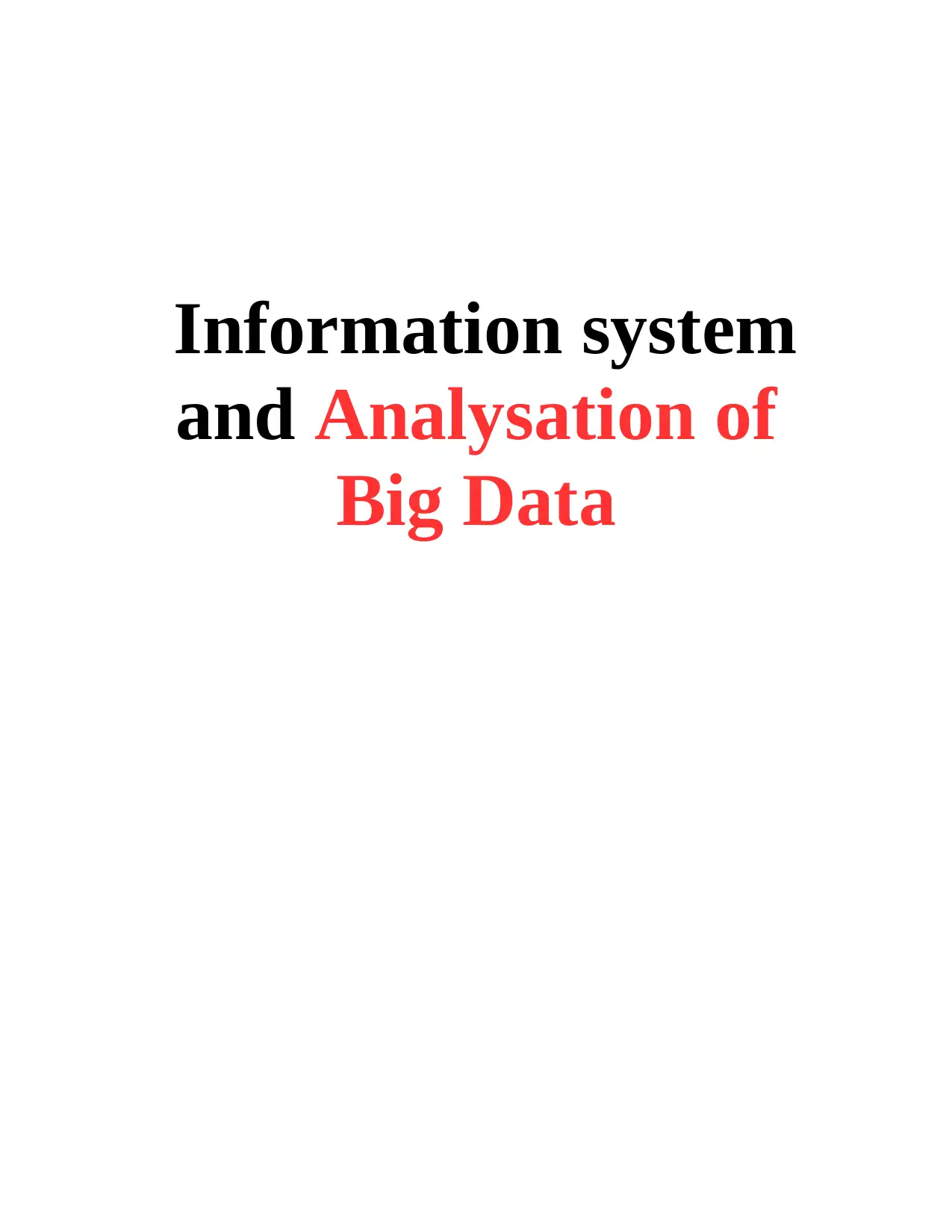
Information system
and Analysation of
Big Data
and Analysation of
Big Data
Secure Best Marks with AI Grader
Need help grading? Try our AI Grader for instant feedback on your assignments.
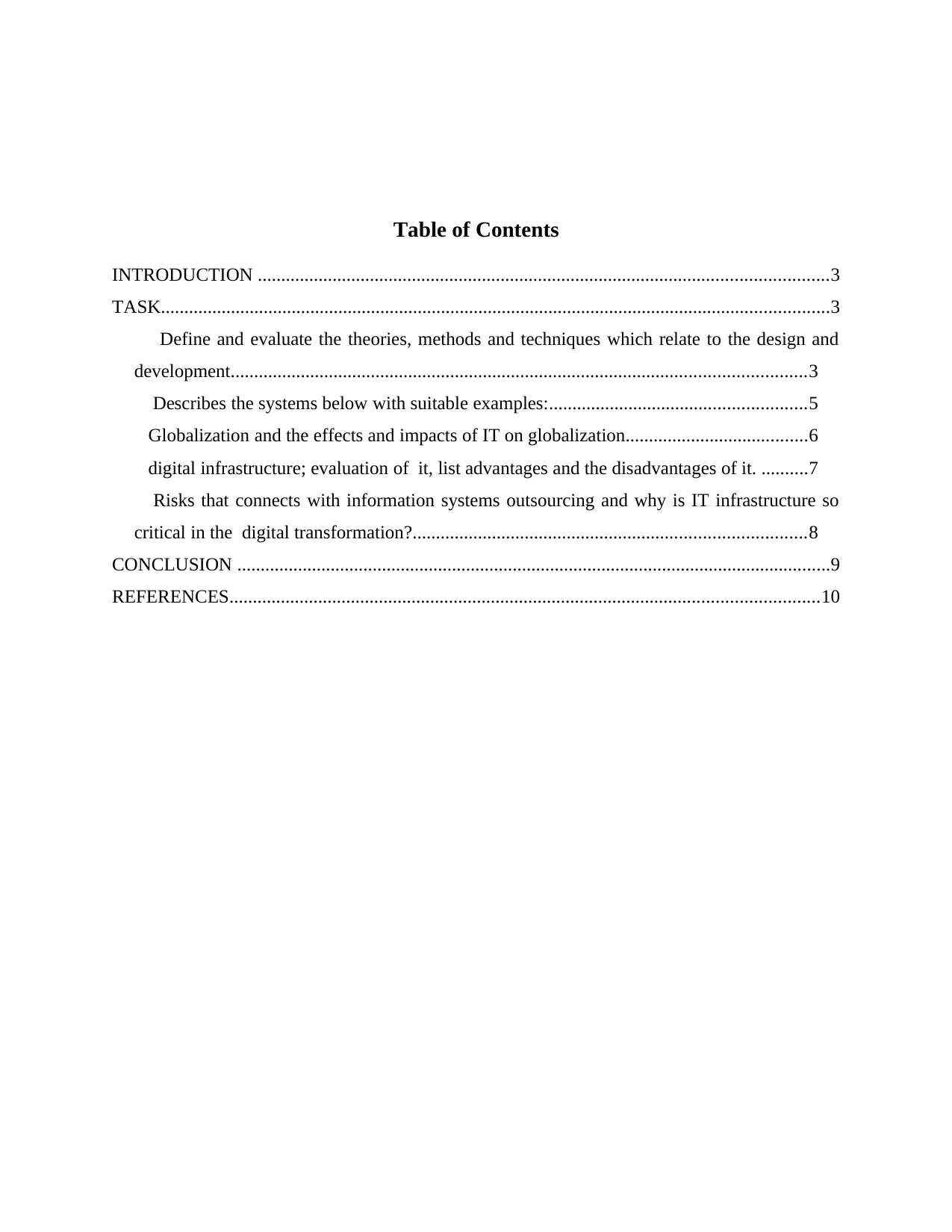
Table of Contents
INTRODUCTION ..........................................................................................................................3
TASK...............................................................................................................................................3
Define and evaluate the theories, methods and techniques which relate to the design and
development...........................................................................................................................3
Describes the systems below with suitable examples:.......................................................5
Globalization and the effects and impacts of IT on globalization.......................................6
digital infrastructure; evaluation of it, list advantages and the disadvantages of it. ..........7
Risks that connects with information systems outsourcing and why is IT infrastructure so
critical in the digital transformation?....................................................................................8
CONCLUSION ...............................................................................................................................9
REFERENCES..............................................................................................................................10
INTRODUCTION ..........................................................................................................................3
TASK...............................................................................................................................................3
Define and evaluate the theories, methods and techniques which relate to the design and
development...........................................................................................................................3
Describes the systems below with suitable examples:.......................................................5
Globalization and the effects and impacts of IT on globalization.......................................6
digital infrastructure; evaluation of it, list advantages and the disadvantages of it. ..........7
Risks that connects with information systems outsourcing and why is IT infrastructure so
critical in the digital transformation?....................................................................................8
CONCLUSION ...............................................................................................................................9
REFERENCES..............................................................................................................................10
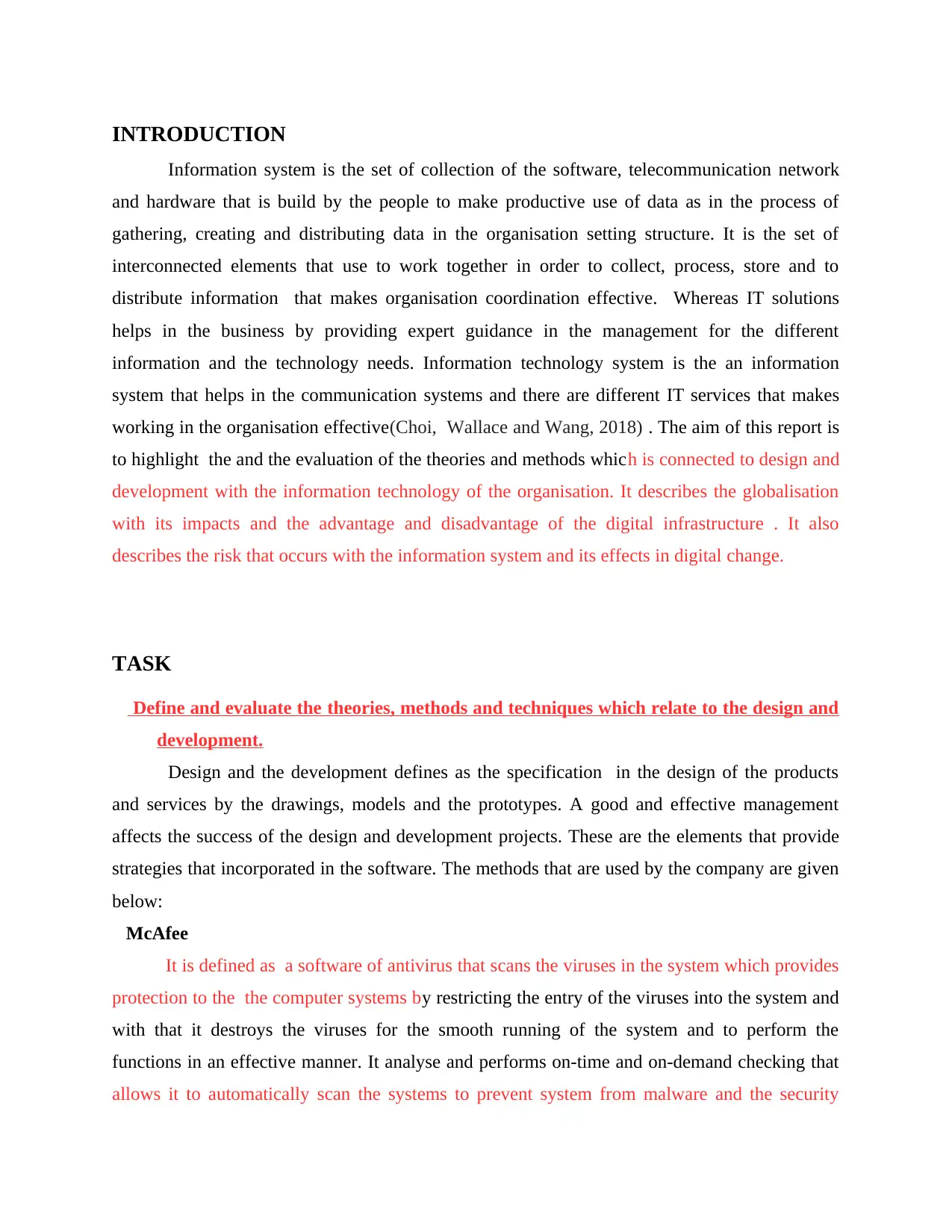
INTRODUCTION
Information system is the set of collection of the software, telecommunication network
and hardware that is build by the people to make productive use of data as in the process of
gathering, creating and distributing data in the organisation setting structure. It is the set of
interconnected elements that use to work together in order to collect, process, store and to
distribute information that makes organisation coordination effective. Whereas IT solutions
helps in the business by providing expert guidance in the management for the different
information and the technology needs. Information technology system is the an information
system that helps in the communication systems and there are different IT services that makes
working in the organisation effective(Choi, Wallace and Wang, 2018) . The aim of this report is
to highlight the and the evaluation of the theories and methods which is connected to design and
development with the information technology of the organisation. It describes the globalisation
with its impacts and the advantage and disadvantage of the digital infrastructure . It also
describes the risk that occurs with the information system and its effects in digital change.
TASK
Define and evaluate the theories, methods and techniques which relate to the design and
development.
Design and the development defines as the specification in the design of the products
and services by the drawings, models and the prototypes. A good and effective management
affects the success of the design and development projects. These are the elements that provide
strategies that incorporated in the software. The methods that are used by the company are given
below:
McAfee
It is defined as a software of antivirus that scans the viruses in the system which provides
protection to the the computer systems by restricting the entry of the viruses into the system and
with that it destroys the viruses for the smooth running of the system and to perform the
functions in an effective manner. It analyse and performs on-time and on-demand checking that
allows it to automatically scan the systems to prevent system from malware and the security
Information system is the set of collection of the software, telecommunication network
and hardware that is build by the people to make productive use of data as in the process of
gathering, creating and distributing data in the organisation setting structure. It is the set of
interconnected elements that use to work together in order to collect, process, store and to
distribute information that makes organisation coordination effective. Whereas IT solutions
helps in the business by providing expert guidance in the management for the different
information and the technology needs. Information technology system is the an information
system that helps in the communication systems and there are different IT services that makes
working in the organisation effective(Choi, Wallace and Wang, 2018) . The aim of this report is
to highlight the and the evaluation of the theories and methods which is connected to design and
development with the information technology of the organisation. It describes the globalisation
with its impacts and the advantage and disadvantage of the digital infrastructure . It also
describes the risk that occurs with the information system and its effects in digital change.
TASK
Define and evaluate the theories, methods and techniques which relate to the design and
development.
Design and the development defines as the specification in the design of the products
and services by the drawings, models and the prototypes. A good and effective management
affects the success of the design and development projects. These are the elements that provide
strategies that incorporated in the software. The methods that are used by the company are given
below:
McAfee
It is defined as a software of antivirus that scans the viruses in the system which provides
protection to the the computer systems by restricting the entry of the viruses into the system and
with that it destroys the viruses for the smooth running of the system and to perform the
functions in an effective manner. It analyse and performs on-time and on-demand checking that
allows it to automatically scan the systems to prevent system from malware and the security
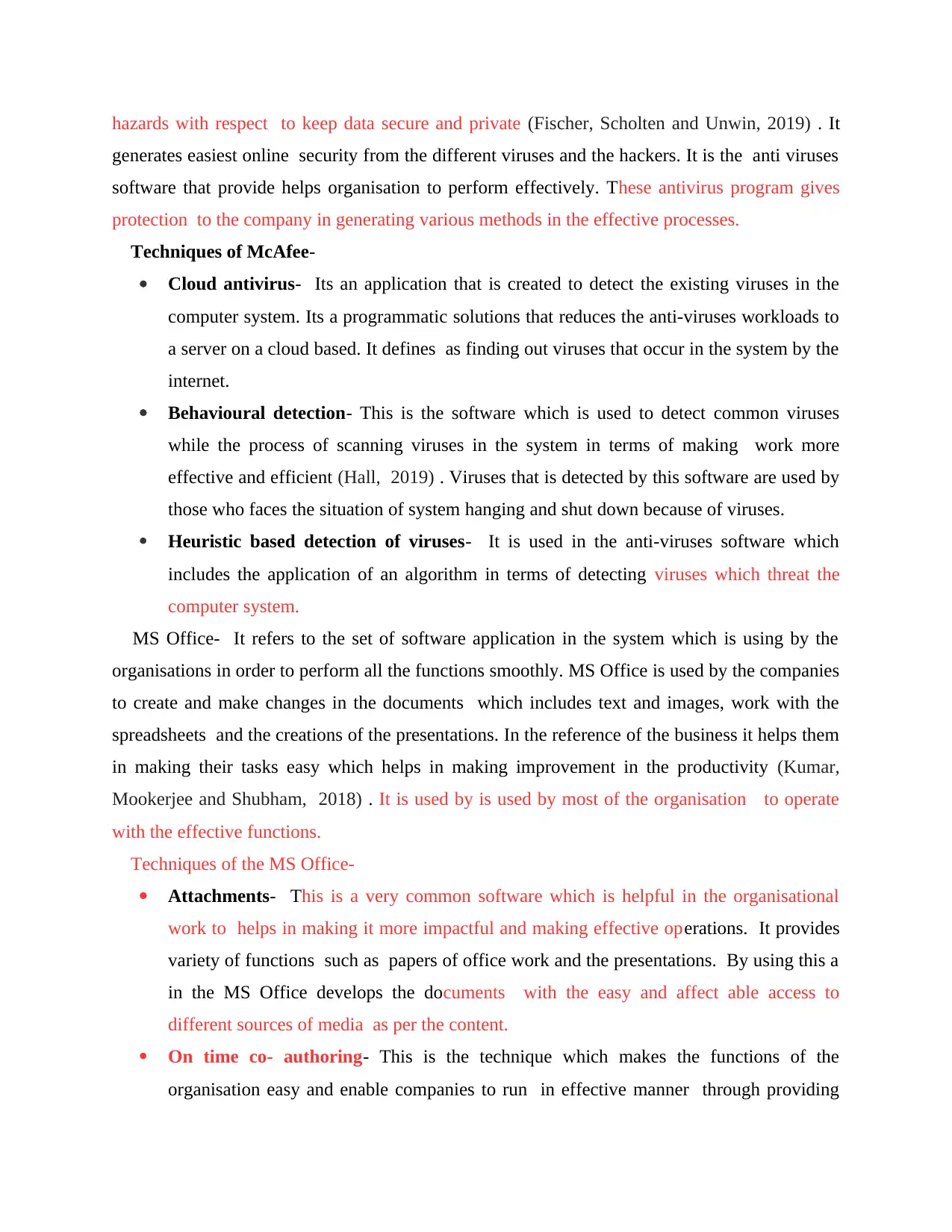
hazards with respect to keep data secure and private (Fischer, Scholten and Unwin, 2019) . It
generates easiest online security from the different viruses and the hackers. It is the anti viruses
software that provide helps organisation to perform effectively. These antivirus program gives
protection to the company in generating various methods in the effective processes.
Techniques of McAfee-
Cloud antivirus- Its an application that is created to detect the existing viruses in the
computer system. Its a programmatic solutions that reduces the anti-viruses workloads to
a server on a cloud based. It defines as finding out viruses that occur in the system by the
internet.
Behavioural detection- This is the software which is used to detect common viruses
while the process of scanning viruses in the system in terms of making work more
effective and efficient (Hall, 2019) . Viruses that is detected by this software are used by
those who faces the situation of system hanging and shut down because of viruses.
Heuristic based detection of viruses- It is used in the anti-viruses software which
includes the application of an algorithm in terms of detecting viruses which threat the
computer system.
MS Office- It refers to the set of software application in the system which is using by the
organisations in order to perform all the functions smoothly. MS Office is used by the companies
to create and make changes in the documents which includes text and images, work with the
spreadsheets and the creations of the presentations. In the reference of the business it helps them
in making their tasks easy which helps in making improvement in the productivity (Kumar,
Mookerjee and Shubham, 2018) . It is used by is used by most of the organisation to operate
with the effective functions.
Techniques of the MS Office-
Attachments- This is a very common software which is helpful in the organisational
work to helps in making it more impactful and making effective operations. It provides
variety of functions such as papers of office work and the presentations. By using this a
in the MS Office develops the documents with the easy and affect able access to
different sources of media as per the content.
On time co- authoring- This is the technique which makes the functions of the
organisation easy and enable companies to run in effective manner through providing
generates easiest online security from the different viruses and the hackers. It is the anti viruses
software that provide helps organisation to perform effectively. These antivirus program gives
protection to the company in generating various methods in the effective processes.
Techniques of McAfee-
Cloud antivirus- Its an application that is created to detect the existing viruses in the
computer system. Its a programmatic solutions that reduces the anti-viruses workloads to
a server on a cloud based. It defines as finding out viruses that occur in the system by the
internet.
Behavioural detection- This is the software which is used to detect common viruses
while the process of scanning viruses in the system in terms of making work more
effective and efficient (Hall, 2019) . Viruses that is detected by this software are used by
those who faces the situation of system hanging and shut down because of viruses.
Heuristic based detection of viruses- It is used in the anti-viruses software which
includes the application of an algorithm in terms of detecting viruses which threat the
computer system.
MS Office- It refers to the set of software application in the system which is using by the
organisations in order to perform all the functions smoothly. MS Office is used by the companies
to create and make changes in the documents which includes text and images, work with the
spreadsheets and the creations of the presentations. In the reference of the business it helps them
in making their tasks easy which helps in making improvement in the productivity (Kumar,
Mookerjee and Shubham, 2018) . It is used by is used by most of the organisation to operate
with the effective functions.
Techniques of the MS Office-
Attachments- This is a very common software which is helpful in the organisational
work to helps in making it more impactful and making effective operations. It provides
variety of functions such as papers of office work and the presentations. By using this a
in the MS Office develops the documents with the easy and affect able access to
different sources of media as per the content.
On time co- authoring- This is the technique which makes the functions of the
organisation easy and enable companies to run in effective manner through providing
Secure Best Marks with AI Grader
Need help grading? Try our AI Grader for instant feedback on your assignments.
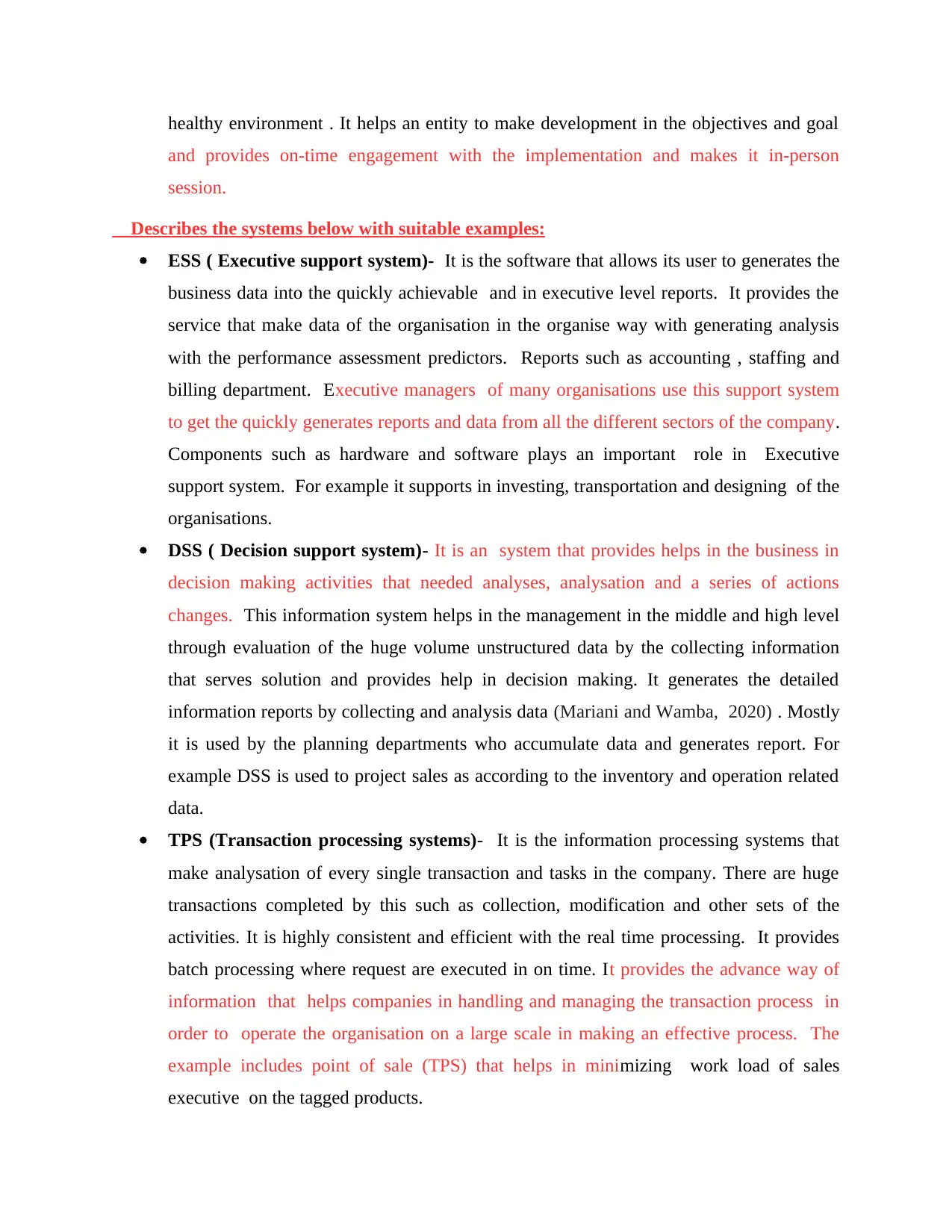
healthy environment . It helps an entity to make development in the objectives and goal
and provides on-time engagement with the implementation and makes it in-person
session.
Describes the systems below with suitable examples:
ESS ( Executive support system)- It is the software that allows its user to generates the
business data into the quickly achievable and in executive level reports. It provides the
service that make data of the organisation in the organise way with generating analysis
with the performance assessment predictors. Reports such as accounting , staffing and
billing department. Executive managers of many organisations use this support system
to get the quickly generates reports and data from all the different sectors of the company.
Components such as hardware and software plays an important role in Executive
support system. For example it supports in investing, transportation and designing of the
organisations.
DSS ( Decision support system)- It is an system that provides helps in the business in
decision making activities that needed analyses, analysation and a series of actions
changes. This information system helps in the management in the middle and high level
through evaluation of the huge volume unstructured data by the collecting information
that serves solution and provides help in decision making. It generates the detailed
information reports by collecting and analysis data (Mariani and Wamba, 2020) . Mostly
it is used by the planning departments who accumulate data and generates report. For
example DSS is used to project sales as according to the inventory and operation related
data.
TPS (Transaction processing systems)- It is the information processing systems that
make analysation of every single transaction and tasks in the company. There are huge
transactions completed by this such as collection, modification and other sets of the
activities. It is highly consistent and efficient with the real time processing. It provides
batch processing where request are executed in on time. It provides the advance way of
information that helps companies in handling and managing the transaction process in
order to operate the organisation on a large scale in making an effective process. The
example includes point of sale (TPS) that helps in minimizing work load of sales
executive on the tagged products.
and provides on-time engagement with the implementation and makes it in-person
session.
Describes the systems below with suitable examples:
ESS ( Executive support system)- It is the software that allows its user to generates the
business data into the quickly achievable and in executive level reports. It provides the
service that make data of the organisation in the organise way with generating analysis
with the performance assessment predictors. Reports such as accounting , staffing and
billing department. Executive managers of many organisations use this support system
to get the quickly generates reports and data from all the different sectors of the company.
Components such as hardware and software plays an important role in Executive
support system. For example it supports in investing, transportation and designing of the
organisations.
DSS ( Decision support system)- It is an system that provides helps in the business in
decision making activities that needed analyses, analysation and a series of actions
changes. This information system helps in the management in the middle and high level
through evaluation of the huge volume unstructured data by the collecting information
that serves solution and provides help in decision making. It generates the detailed
information reports by collecting and analysis data (Mariani and Wamba, 2020) . Mostly
it is used by the planning departments who accumulate data and generates report. For
example DSS is used to project sales as according to the inventory and operation related
data.
TPS (Transaction processing systems)- It is the information processing systems that
make analysation of every single transaction and tasks in the company. There are huge
transactions completed by this such as collection, modification and other sets of the
activities. It is highly consistent and efficient with the real time processing. It provides
batch processing where request are executed in on time. It provides the advance way of
information that helps companies in handling and managing the transaction process in
order to operate the organisation on a large scale in making an effective process. The
example includes point of sale (TPS) that helps in minimizing work load of sales
executive on the tagged products.
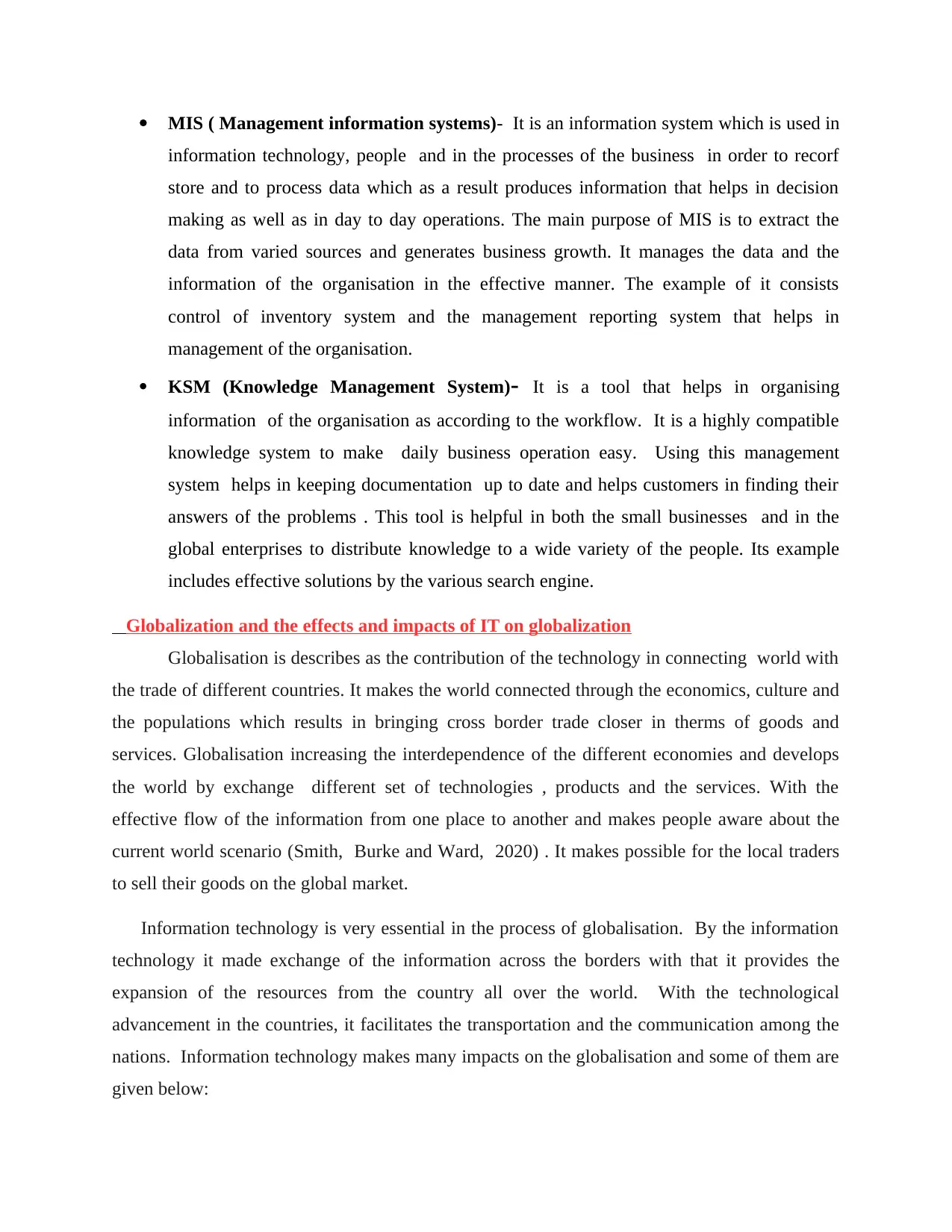
MIS ( Management information systems)- It is an information system which is used in
information technology, people and in the processes of the business in order to recorf
store and to process data which as a result produces information that helps in decision
making as well as in day to day operations. The main purpose of MIS is to extract the
data from varied sources and generates business growth. It manages the data and the
information of the organisation in the effective manner. The example of it consists
control of inventory system and the management reporting system that helps in
management of the organisation.
KSM (Knowledge Management System)- It is a tool that helps in organising
information of the organisation as according to the workflow. It is a highly compatible
knowledge system to make daily business operation easy. Using this management
system helps in keeping documentation up to date and helps customers in finding their
answers of the problems . This tool is helpful in both the small businesses and in the
global enterprises to distribute knowledge to a wide variety of the people. Its example
includes effective solutions by the various search engine.
Globalization and the effects and impacts of IT on globalization
Globalisation is describes as the contribution of the technology in connecting world with
the trade of different countries. It makes the world connected through the economics, culture and
the populations which results in bringing cross border trade closer in therms of goods and
services. Globalisation increasing the interdependence of the different economies and develops
the world by exchange different set of technologies , products and the services. With the
effective flow of the information from one place to another and makes people aware about the
current world scenario (Smith, Burke and Ward, 2020) . It makes possible for the local traders
to sell their goods on the global market.
Information technology is very essential in the process of globalisation. By the information
technology it made exchange of the information across the borders with that it provides the
expansion of the resources from the country all over the world. With the technological
advancement in the countries, it facilitates the transportation and the communication among the
nations. Information technology makes many impacts on the globalisation and some of them are
given below:
information technology, people and in the processes of the business in order to recorf
store and to process data which as a result produces information that helps in decision
making as well as in day to day operations. The main purpose of MIS is to extract the
data from varied sources and generates business growth. It manages the data and the
information of the organisation in the effective manner. The example of it consists
control of inventory system and the management reporting system that helps in
management of the organisation.
KSM (Knowledge Management System)- It is a tool that helps in organising
information of the organisation as according to the workflow. It is a highly compatible
knowledge system to make daily business operation easy. Using this management
system helps in keeping documentation up to date and helps customers in finding their
answers of the problems . This tool is helpful in both the small businesses and in the
global enterprises to distribute knowledge to a wide variety of the people. Its example
includes effective solutions by the various search engine.
Globalization and the effects and impacts of IT on globalization
Globalisation is describes as the contribution of the technology in connecting world with
the trade of different countries. It makes the world connected through the economics, culture and
the populations which results in bringing cross border trade closer in therms of goods and
services. Globalisation increasing the interdependence of the different economies and develops
the world by exchange different set of technologies , products and the services. With the
effective flow of the information from one place to another and makes people aware about the
current world scenario (Smith, Burke and Ward, 2020) . It makes possible for the local traders
to sell their goods on the global market.
Information technology is very essential in the process of globalisation. By the information
technology it made exchange of the information across the borders with that it provides the
expansion of the resources from the country all over the world. With the technological
advancement in the countries, it facilitates the transportation and the communication among the
nations. Information technology makes many impacts on the globalisation and some of them are
given below:

Technological advancement- Information technology adds up modern technology and
generates the technological advancement in the process of communication and connects
the modes of transportation between different nations and provides the sourcing of the
raw materials and the inputs around the world.
Facilitates the connections between nations- Information technology helps in
connecting nations in context of trade and security and because of the interconnected
nations its being easy to solve the problems with the help of other countries. For example
such as world wide web reduces the barriers of time.
Strengthen out the political, social ,cultural and the economics practices- This is
defines as the practices and the decision that being made in one part of the world affects
the communities and the cultures around the world.
digital infrastructure; evaluation of it, list advantages and the disadvantages of it.
It is define as the infrastructure that provides the support for the management and enables
the business for its development and provide increment in the effectiveness in doing business.
Digital infrastructure interconnects the physical and the virtual technologies such as storage ,
network and compute data. Business uses this framework to re-build their functions and services
for a global digital delivery (Steininger, 2019). It generates the base for the organisation
information technology and enables the foundation of connectivity between the nations.
Advantages
Brings information- Digital infrastructure generates each and every required
information with in seconds by the access of the data by different sources. With the use
of the computer and the phones with the internet that allows a person to get the answers
of the queries.
New development opportunities- By developing economic sector and by generating
many opportunities through the interconnected nations , it helps in generating
development opportunities. It also help countries to be more updated.
Disadvantage
generates the technological advancement in the process of communication and connects
the modes of transportation between different nations and provides the sourcing of the
raw materials and the inputs around the world.
Facilitates the connections between nations- Information technology helps in
connecting nations in context of trade and security and because of the interconnected
nations its being easy to solve the problems with the help of other countries. For example
such as world wide web reduces the barriers of time.
Strengthen out the political, social ,cultural and the economics practices- This is
defines as the practices and the decision that being made in one part of the world affects
the communities and the cultures around the world.
digital infrastructure; evaluation of it, list advantages and the disadvantages of it.
It is define as the infrastructure that provides the support for the management and enables
the business for its development and provide increment in the effectiveness in doing business.
Digital infrastructure interconnects the physical and the virtual technologies such as storage ,
network and compute data. Business uses this framework to re-build their functions and services
for a global digital delivery (Steininger, 2019). It generates the base for the organisation
information technology and enables the foundation of connectivity between the nations.
Advantages
Brings information- Digital infrastructure generates each and every required
information with in seconds by the access of the data by different sources. With the use
of the computer and the phones with the internet that allows a person to get the answers
of the queries.
New development opportunities- By developing economic sector and by generating
many opportunities through the interconnected nations , it helps in generating
development opportunities. It also help countries to be more updated.
Disadvantage
Paraphrase This Document
Need a fresh take? Get an instant paraphrase of this document with our AI Paraphraser
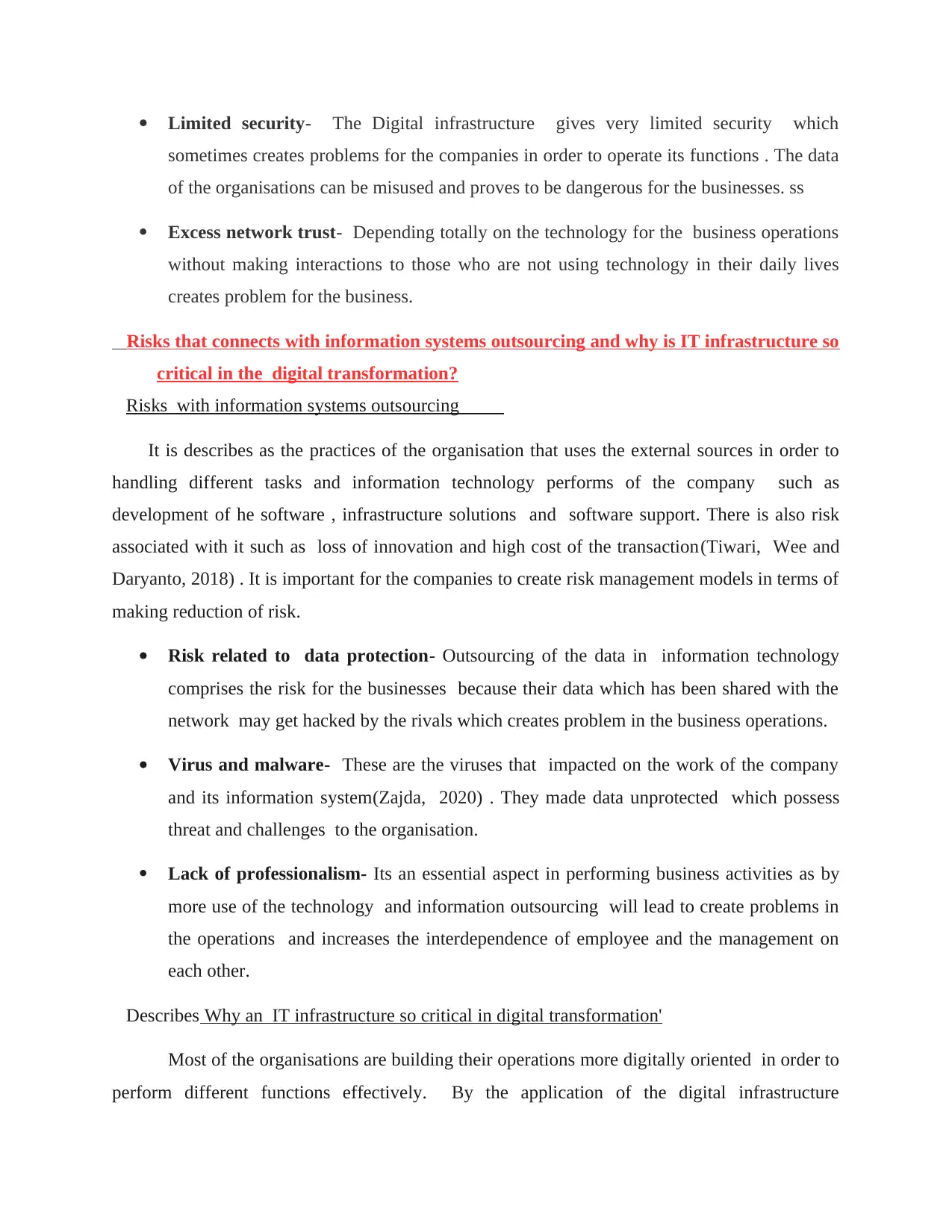
Limited security- The Digital infrastructure gives very limited security which
sometimes creates problems for the companies in order to operate its functions . The data
of the organisations can be misused and proves to be dangerous for the businesses. ss
Excess network trust- Depending totally on the technology for the business operations
without making interactions to those who are not using technology in their daily lives
creates problem for the business.
Risks that connects with information systems outsourcing and why is IT infrastructure so
critical in the digital transformation?
Risks with information systems outsourcing
It is describes as the practices of the organisation that uses the external sources in order to
handling different tasks and information technology performs of the company such as
development of he software , infrastructure solutions and software support. There is also risk
associated with it such as loss of innovation and high cost of the transaction(Tiwari, Wee and
Daryanto, 2018) . It is important for the companies to create risk management models in terms of
making reduction of risk.
Risk related to data protection- Outsourcing of the data in information technology
comprises the risk for the businesses because their data which has been shared with the
network may get hacked by the rivals which creates problem in the business operations.
Virus and malware- These are the viruses that impacted on the work of the company
and its information system(Zajda, 2020) . They made data unprotected which possess
threat and challenges to the organisation.
Lack of professionalism- Its an essential aspect in performing business activities as by
more use of the technology and information outsourcing will lead to create problems in
the operations and increases the interdependence of employee and the management on
each other.
Describes Why an IT infrastructure so critical in digital transformation'
Most of the organisations are building their operations more digitally oriented in order to
perform different functions effectively. By the application of the digital infrastructure
sometimes creates problems for the companies in order to operate its functions . The data
of the organisations can be misused and proves to be dangerous for the businesses. ss
Excess network trust- Depending totally on the technology for the business operations
without making interactions to those who are not using technology in their daily lives
creates problem for the business.
Risks that connects with information systems outsourcing and why is IT infrastructure so
critical in the digital transformation?
Risks with information systems outsourcing
It is describes as the practices of the organisation that uses the external sources in order to
handling different tasks and information technology performs of the company such as
development of he software , infrastructure solutions and software support. There is also risk
associated with it such as loss of innovation and high cost of the transaction(Tiwari, Wee and
Daryanto, 2018) . It is important for the companies to create risk management models in terms of
making reduction of risk.
Risk related to data protection- Outsourcing of the data in information technology
comprises the risk for the businesses because their data which has been shared with the
network may get hacked by the rivals which creates problem in the business operations.
Virus and malware- These are the viruses that impacted on the work of the company
and its information system(Zajda, 2020) . They made data unprotected which possess
threat and challenges to the organisation.
Lack of professionalism- Its an essential aspect in performing business activities as by
more use of the technology and information outsourcing will lead to create problems in
the operations and increases the interdependence of employee and the management on
each other.
Describes Why an IT infrastructure so critical in digital transformation'
Most of the organisations are building their operations more digitally oriented in order to
perform different functions effectively. By the application of the digital infrastructure
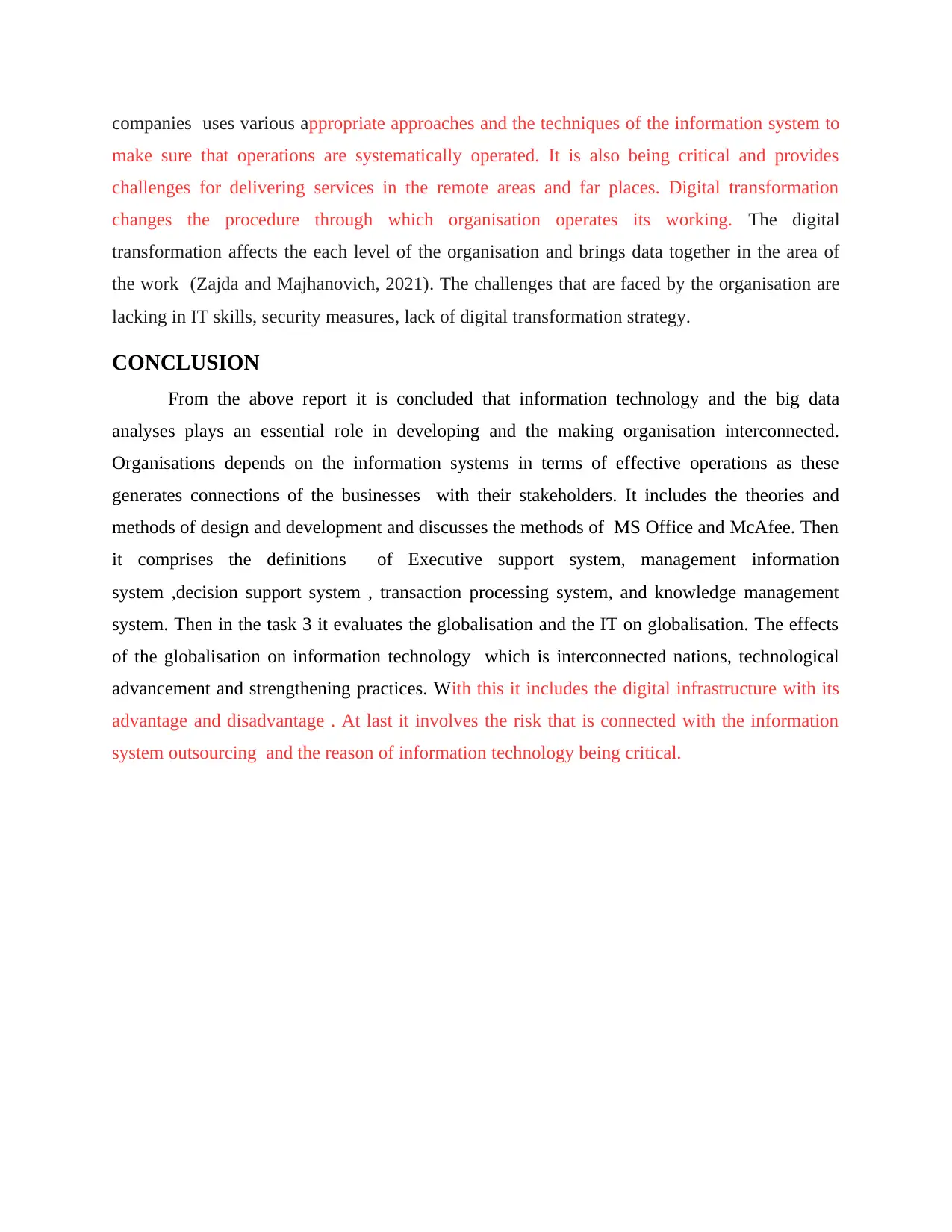
companies uses various appropriate approaches and the techniques of the information system to
make sure that operations are systematically operated. It is also being critical and provides
challenges for delivering services in the remote areas and far places. Digital transformation
changes the procedure through which organisation operates its working. The digital
transformation affects the each level of the organisation and brings data together in the area of
the work (Zajda and Majhanovich, 2021). The challenges that are faced by the organisation are
lacking in IT skills, security measures, lack of digital transformation strategy.
CONCLUSION
From the above report it is concluded that information technology and the big data
analyses plays an essential role in developing and the making organisation interconnected.
Organisations depends on the information systems in terms of effective operations as these
generates connections of the businesses with their stakeholders. It includes the theories and
methods of design and development and discusses the methods of MS Office and McAfee. Then
it comprises the definitions of Executive support system, management information
system ,decision support system , transaction processing system, and knowledge management
system. Then in the task 3 it evaluates the globalisation and the IT on globalisation. The effects
of the globalisation on information technology which is interconnected nations, technological
advancement and strengthening practices. With this it includes the digital infrastructure with its
advantage and disadvantage . At last it involves the risk that is connected with the information
system outsourcing and the reason of information technology being critical.
make sure that operations are systematically operated. It is also being critical and provides
challenges for delivering services in the remote areas and far places. Digital transformation
changes the procedure through which organisation operates its working. The digital
transformation affects the each level of the organisation and brings data together in the area of
the work (Zajda and Majhanovich, 2021). The challenges that are faced by the organisation are
lacking in IT skills, security measures, lack of digital transformation strategy.
CONCLUSION
From the above report it is concluded that information technology and the big data
analyses plays an essential role in developing and the making organisation interconnected.
Organisations depends on the information systems in terms of effective operations as these
generates connections of the businesses with their stakeholders. It includes the theories and
methods of design and development and discusses the methods of MS Office and McAfee. Then
it comprises the definitions of Executive support system, management information
system ,decision support system , transaction processing system, and knowledge management
system. Then in the task 3 it evaluates the globalisation and the IT on globalisation. The effects
of the globalisation on information technology which is interconnected nations, technological
advancement and strengthening practices. With this it includes the digital infrastructure with its
advantage and disadvantage . At last it involves the risk that is connected with the information
system outsourcing and the reason of information technology being critical.

REFERENCES
Books and Journal
Choi, T.M., Wallace, S.W. and Wang, Y., 2018. Big data analytics in operations
management. Production and Operations Management, 27(10), pp.1868-1883.
Fischer, M.M., Scholten, H.J. and Unwin, D., 2019. Geographic information systems, spatial
data analysis and spatial modelling: an introduction. In Spatial analytical perspectives on
GIS (pp. 3-20). Routledge.
Hall, C.M., 2019. Biological invasion, biosecurity, tourism, and globalisation. In Handbook of
globalisation and tourism. Edward Elgar Publishing.
Kumar, S., Mookerjee, V. and Shubham, A., 2018. Research in operations management and
information systems interface. Production and Operations Management, 27(11), pp.1893-1905.
Mariani, M.M. and Wamba, S.F., 2020. Exploring how consumer goods companies innovate in
the digital age: The role of big data analytics companies. Journal of Business Research, 121,
pp.338-352.
Smith, C., Burke, H. and Ward, G.K., 2020. Globalisation and indigenous peoples: threat or
empowerment?. In Indigenous cultures in an interconnected world (pp. xviii-24). Routledge.
Steininger, D.M., 2019. Linking information systems and entrepreneurship: A review and agenda
for IT‐associated and digital entrepreneurship research. Information Systems Journal, 29(2),
pp.363-407.
Tiwari, S., Wee, H.M. and Daryanto, Y., 2018. Big data analytics in supply chain management
between 2010 and 2016: Insights to industries. Computers & Industrial Engineering, 115,
pp.319-330.
Zajda, J. ed., 2020. Globalisation, ideology and neo-liberal higher education reforms. Dordrecht:
Springer.
Zajda, J.I. and Majhanovich, S. eds., 2021. Globalisation, cultural identity and nation-building:
The changing paradigms. Dordrecht: Springer.
Books and Journal
Choi, T.M., Wallace, S.W. and Wang, Y., 2018. Big data analytics in operations
management. Production and Operations Management, 27(10), pp.1868-1883.
Fischer, M.M., Scholten, H.J. and Unwin, D., 2019. Geographic information systems, spatial
data analysis and spatial modelling: an introduction. In Spatial analytical perspectives on
GIS (pp. 3-20). Routledge.
Hall, C.M., 2019. Biological invasion, biosecurity, tourism, and globalisation. In Handbook of
globalisation and tourism. Edward Elgar Publishing.
Kumar, S., Mookerjee, V. and Shubham, A., 2018. Research in operations management and
information systems interface. Production and Operations Management, 27(11), pp.1893-1905.
Mariani, M.M. and Wamba, S.F., 2020. Exploring how consumer goods companies innovate in
the digital age: The role of big data analytics companies. Journal of Business Research, 121,
pp.338-352.
Smith, C., Burke, H. and Ward, G.K., 2020. Globalisation and indigenous peoples: threat or
empowerment?. In Indigenous cultures in an interconnected world (pp. xviii-24). Routledge.
Steininger, D.M., 2019. Linking information systems and entrepreneurship: A review and agenda
for IT‐associated and digital entrepreneurship research. Information Systems Journal, 29(2),
pp.363-407.
Tiwari, S., Wee, H.M. and Daryanto, Y., 2018. Big data analytics in supply chain management
between 2010 and 2016: Insights to industries. Computers & Industrial Engineering, 115,
pp.319-330.
Zajda, J. ed., 2020. Globalisation, ideology and neo-liberal higher education reforms. Dordrecht:
Springer.
Zajda, J.I. and Majhanovich, S. eds., 2021. Globalisation, cultural identity and nation-building:
The changing paradigms. Dordrecht: Springer.
1 out of 10
Related Documents
Your All-in-One AI-Powered Toolkit for Academic Success.
+13062052269
info@desklib.com
Available 24*7 on WhatsApp / Email
![[object Object]](/_next/static/media/star-bottom.7253800d.svg)
Unlock your academic potential
© 2024 | Zucol Services PVT LTD | All rights reserved.





